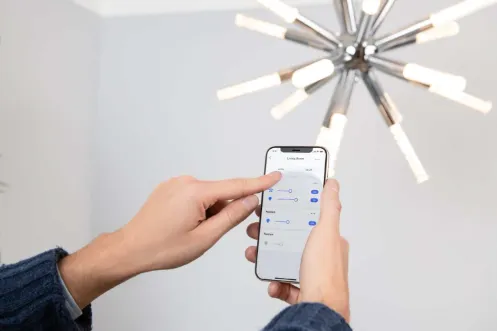Installing smart lights can be risky if you’re not careful about power surges. These sudden spikes in electricity can damage your new smart bulbs, destroy your home’s wiring, or even cause fires. These power surges happen quickly and can cost you a lot of money in repairs.
To stay safe, you need some basic steps. Using power protectors, turning off electricity before starting, and checking if all parts match are important. Working with a trained electrician can also help keep your home safe.
While these basic precautions are vital, protecting your smart lighting system requires additional advanced measures. This article provides essential tips on safeguarding your smart lighting installation from electrical surges, using surge-proof smart lighting options, and taking protective measures during setup.
What Are Electrical Surges?
Electrical surges, or spikes in voltage, occur when the flow of electricity is suddenly interrupted and then resumed. This disruption sends a burst of energy that can travel through your electrical system. A surge can result from several sources, including:
- Lightning strikes: Although rare, lightning can cause extremely powerful surges.
- Power outages: When power is restored, a sudden influx of electricity may cause a surge.
- Malfunctioning appliances: Certain devices may release extra energy back into your electrical system, causing a voltage spike.
- Improper wiring: Loose or poor wiring in your home can contribute to irregular electrical flows.
Surges can damage sensitive electronics and permanently impair smart lighting setups. By understanding the risks, you can take steps to prevent these issues and ensure a long-lasting, protective lighting installation for your smart home.
Why Are Smart Lighting Systems Vulnerable?
Smart lighting systems consist of interconnected devices, including switches, dimmers, sensors, and smart bulbs. These elements communicate with each other and sometimes with other smart home systems over Wi-Fi or Zigbee networks. Each device is an entry point for potential electrical interference. Here are a few reasons smart lighting systems are especially fragile:
- Delicate electronics: The internal components in smart lighting are more sensitive than in traditional lighting.
- Continuous connectivity: Many smart lighting systems are constantly connected to a power source, increasing the chance of encountering a surge.
- Expensive equipment: Surge damage in smart lighting systems often leads to costly repairs or replacements.
Implementing preventive measures can save you from unexpected repair costs and ensure your lighting system operates smoothly.
Practical Tips to Avoid Electrical Surges During Installation
Now that you understand the risks let’s look at actionable steps to avoid electrical surges when setting up your smart lighting.
1. Use Surge-Protected Power Strips
Surge-protected power strips are affordable to protect smaller setups or individual devices. These strips have built-in surge protection, diverting excess electricity from your devices. Place your smart lighting hubs, controllers, or even lamps on these power strips for an additional layer of security.
2. Invest in a Whole-Home Surge Protector
For more comprehensive protection, consider installing a whole-home surge protector. This device is installed at your electrical panel, protecting your home’s electrical system. A whole-home surge protector diverts excess voltage back to the ground, safeguarding all connected devices from surges, including smart lighting.
If you’re installing large-scale protective lighting, especially in a multi-room setup, whole-home surge protection can be a wise investment.
3. Choose Surge-Proof Smart Lighting Components
When buying components for your smart lighting, look for items labeled as surge-proof smart lighting. These products are designed with surge-protection capabilities that add a buffer against potential electrical spikes. Not only do they enhance reliability, but they also save you money on repairs and replacements. Many manufacturers offer surge-resistant bulbs, switches, and dimmers specifically designed for smart systems.
4. Double-Check Wiring and Grounding
Proper wiring and grounding play a significant role in managing electrical surges. Before installing your smart lighting system, ensure your home’s wiring is up to code. Faulty wiring can cause shorts and surges, risking your lighting setup. Additionally, all components should be correctly grounded to safely direct any excess electricity away from sensitive equipment.
5. Avoid Overloading Circuits
Overloading a circuit with too many devices is a common cause of electrical surges. Each circuit has a maximum load, so consider what’s connected in any area. Spreading out your smart lighting devices across multiple circuits can reduce the likelihood of a surge affecting your entire system. When in doubt, consult a qualified electrician who can assess your home’s capacity and recommend appropriate measures.
What to Do If a Surge Occurs
Despite taking all necessary precautions, a surge may still occur. If you suspect a surge has happened, take these steps:
- Unplug affected devices: Remove any affected components from their power sources immediately to prevent further damage.
- Inspect for damage: Check your smart lighting devices for visible signs of damage, such as burns or strange odors.
- Reset your system: A simple reset can sometimes fix minor surge-related issues.
- Consult a professional: If the damage seems extensive, it’s best to have a professional assess and repair your smart lighting setup.
Conclusion
Smart lighting offers an exciting way to automate and enhance your living space, but electrical surges can threaten the functionality and lifespan of these systems. You can shield your lighting setup from unexpected power spikes by implementing spike-proof smart lighting, choosing high-quality components, and installing whole-home surge protection. Following these best practices protects your devices and provides peace of mind. Thus, taking preventive steps before, during, and after installation will ensure that your smart lighting system remains reliable and resilient for years.
